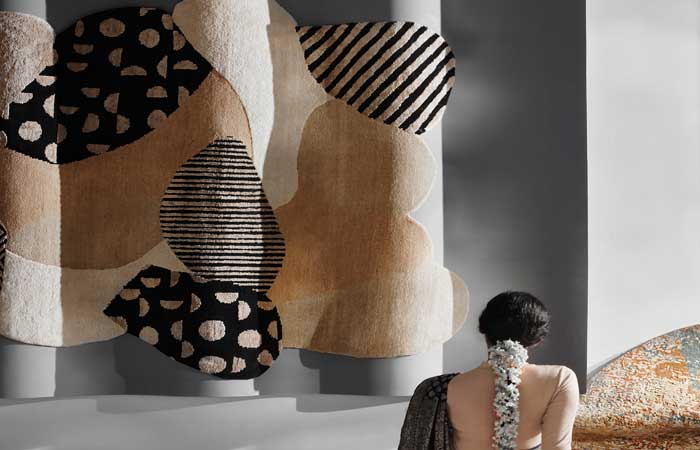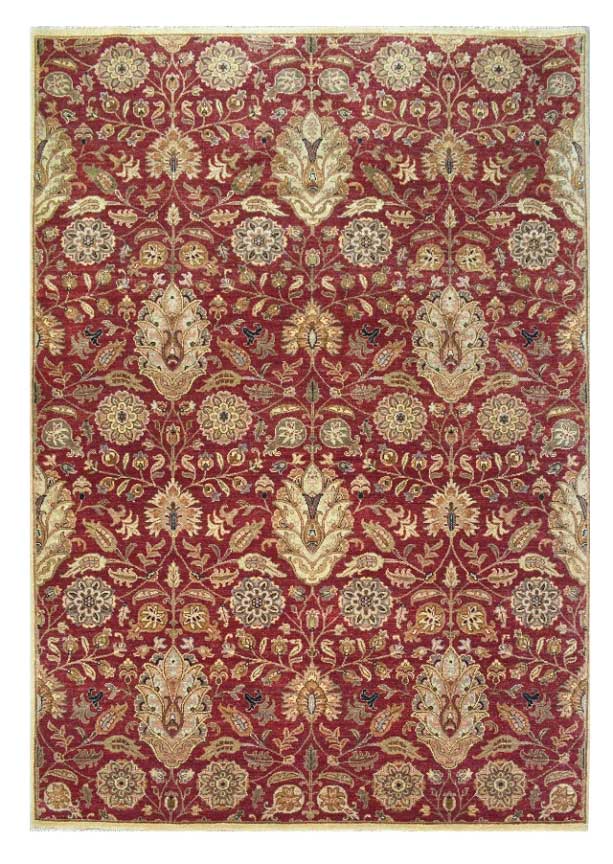
Rug resilience: Exploring durability and longevity in textile innovations
Rug resilience is not just about being practical; it’s an art that blends old-school craftsmanship with new-age innovation, informs Smriti Choudhary.
Charles Dickens wrote in his famous novel Bleak House, “Under every carpet is a secret waiting to be discoveredâ€. Life as Dickens knew might have dramatically changed from the 19th Century but the carpet has steadfastly remained a loyal friend in homes across the world. Rugs have stood the test of time, weathered storms and yet remained an integral part of the journey of homes through the ages. People might ‘brushed a lot under the carpet’ but these carpets have stood the test of time. Perhaps that’s why the word resilience seems to be a perfect fit for rugs. Literally and metaphorically, rugs have been the world beneath our feet that have seen generations come and go. They’ve been part of the celebrations as well as heartbreaks. Even as we move towards a sustainable world, it’s a given to embrace durability and longevity in rug textiles that can help the rug to be more resilient than it already it. In the intricate tapestry of the textile, the world of carpets and its elegance seamlessly intertwines with steadfast commitment to sustainability. Rugs, from the detailed tapestries of Persia to the tribal designs of nomadic cultures, have always served a purpose beyond decoration. Throughout history, these textiles symbolised status, showcased craftsmanship, and reflected cultural identity.
Rug resilience is not just about being practical; it’s an art that blends old-school craftsmanship with new-age innovation. In this deep dive, we’ve explored the history of rugs, looked at how materials and weaving methods affect them, and imagined a future where durability and lasting quality shape textile innovation. As we weave through the past, present, and future, rugs showcase the lasting beauty of human creativity and cleverness.
Time tested
Over 5,000 years ago, nomadic tribes hand-wove rugs out of camel, sheep, and goat hair. Archaeologists have uncovered evidence of rugs in Egyptian and Mesopotamian tombs dating back more than 4,000 years. The oldest known surviving rug is the Pazyryk Carpet, which dates back to 500 BC. Believed to be the world’s oldest example of a knotted-pile carpet and is kept at the State Hermitage Museum in St. Petersburg, Russia, the carpet, which was made out of new wool at around 400 BC, is one of the most fascinating examples rug resilience.
However, traditional rug-making techniques varied in terms of durability, and it depended on several factors such as the materials used, the weaving method, and the intended purpose of the rug. Many traditional rugs, especially those crafted using hand-knotting or hand-weaving methods, were quite durability. The intricate craftsmanship and quality materials, such as wool or silk, contributed to the resilience of these rugs.
The resilience of rugs though depends on multiple factors including the textile used, the purpose of the rug and factors like climate, maintenance, and the specific weaving technique employed could impact the overall durability of traditional rugs.
The role of textile innovations

The resilience of the Pazyryk Carpet is one of a kind and as time passed, science made many breakthroughs to not just make rugs durable but also make the process as sustainable as possible. Take for example the idea of repurposing and breathing new life into discarded waste yarns. Through a transformative process, these abandoned materials undergo a metamorphosis, emerging as statements of refined beauty that transcend conventional boundaries. Beyond exquisite craftsmanship, these rugs symbolise a conscious decision to weave elegance with threads of responsibility. The act of repurposing waste yarns into these elegant rugs is a gesture towards responsible consumption and mindful creation.
Understanding the hand-tufting process
Hand-tufting is a process where carpets undergo distinctive and intricate crafting techniques, wherein strands of yarn are skilfully punched through a canvas backing using a tufting gun. This distinctive method sets them apart from their hand-knotted counterparts, endowing hand-tufted rugs with a unique blend of affordability and design. With the advancement in machinery used for hand-tufting, it helps in improving precision and automation. Computer-aided technology could be integrated into the process, allowing for more intricate and complex designs. The hand-tufting process might now focus on being more environmentally friendly. This includes using recycled materials, eco-conscious dyeing methods, and reducing energy consumption during production.
Material matters
The durability of any carpet is intricately tied to the quality of materials used in its crafting. In the realm of hand-tufted carpets, the age-old preference has centred around wool, a natural fibre revered for its inherent resilience and luxurious softness. Wool not only provides a plush and comfortable feel underfoot but is also known for its ability to withstand wear and tear over time. Its natural elasticity allows the fibres to bounce back, maintaining the carpet’s appearance even in high-traffic areas.
The meticulous selection of premium materials serves as the foundation for a carpet that not only endures the test of time but also means enduring strength and resilience. Beyond their practical benefits, these materials contribute to the overall aesthetic appeal, offering a diverse range of textures, colours, and patterns to cater to various design preferences. Whether opting for the time-tested elegance of wool or the modern advantages of synthetic fibres, the choice of materials remains a critical factor in achieving a hand-tufted carpet that harmonises durability with lasting beauty.
More often than not, handmade rugs in India are made by skilled craftsmen handed down several generations of a family. Made with natural fibres such silk, cotton, wool and even jute, these are meant to last a lifetime. The yarns are hand spun or hand-carded giving them different unique textures and looks. There is almost no mechanisation involved in the different processes, leading to a minimum carbon footprint during manufacturing. For cotton, sustainable farming avoids harmful chemicals, promoting healthy soil and biodiversity. Ethical dyeing methods also make these rugs better for the Earth. Silk, known for its luxurious feel, can be produced sustainably too. Peace silk, or Ahimsa silk, is made without hurting the silkworm, making it a cruelty-free choice. Rugs made from sustainably sourced silk are not only fancy but also match ethical and environmental values.
Construction techniques
While hand-tufting stands as a less labour-intensive method compared to hand-knotting, the durability of the final product is profoundly influenced by the construction techniques applied. In the tufting process, the yarn is skilfully secured with latex onto a canvas backing. Here, the pivotal factor lies in the density of tufting, signifying the number of tufts per square inch. A higher tuft density emerges as a critical determinant, often yielding a carpet of superior durability and resilience that stands robustly against the trials of time.
A higher tuft density contributes to the durability and resilience of the hand-tufted carpet. A densely tufted rug typically exhibits superior strength, with more yarn securely held in place. This not only enhances the carpet’s ability to withstand foot traffic and daily wear but also contributes to a fuller, more luxurious appearance. The robustness achieved through higher tuft density ensures that the carpet stands firm against the trials of time, maintaining its original allure even in high-traffic areas.
Beyond tuft density, the skilfulness of the artisans involved in the hand-tufting process plays a significant role. The precision with which the yarn is anchored, the uniformity of the tufting, and the overall craftsmanship contribute to the carpet’s overall quality and longevity. Additionally, advancements in technology have led to innovations in tufting machines, allowing for greater precision and efficiency in the production of hand-tufted rugs.
Maintenance for longevity
Prudent care and meticulous maintenance are essential to guarantee the beauty of hand-tufted carpets. A routine of regular vacuuming becomes the first line of defence, resisting the buildup of dirt and debris that could compromise the carpet’s integrity. Swift action in cleaning spills is equally crucial, preventing stains from taking root and becoming permanent blemishes. Periodic professional cleaning, tailored to the unique needs of hand-tufted carpets, serves as a rejuvenating process, breathing new life into the fibres and preserving their initial lustre.
Rugs have never been a mere floor covering be it the ancient Indian era and royal Mughal rule or modern-day aesthetic preference, rugs have become the ultimate part of the interior design realm. Today we can boldly state that the role of rugs goes beyond mere floor coverings, they are statements of style, comfort, and functionality.
Design for versatility
Understanding the dynamic nature of interior spaces, where adaptability plays a key role is a major responsibility which often leads the way to versatile aesthetics. Today, rugs are designed for versatility, to ensure they seamlessly integrate into diverse environments, from contemporary apartments to traditional homes. The use of advanced fibres and weaves not only contributes to the visual appeal but also ensures resilience against wear, and tear. This commitment to material excellence is reflected in rugs that look exquisite and endure the challenges of daily life. More importantly, versatility comes with understanding and recognising the diverse preferences of clientele, and we take immense pride in prioritising the demands of the clients.
Another important aspect of versatility is tailor-made rug fitting. Rugs can cater to different room functionalities. Whether it’s a cosy bedroom, a bustling living room, or a formal dining area, rugs in the contemporary world are crafted with the specific requirements of each space in mind.
Design for affective capacity
Beyond visual aesthetics, rugs also evoke emotions and create a sensory experience. The use of high-quality materials, innovative textures, and intricate craftsmanship not only enhances the tactile experience but also contributes to the emotional resonance of the rug. The idea is to provide a canvas that tells a unique story, connecting with individuals on a personal level and establishing an enduring bond.
Design concept and aesthetic balance
At the heart of rug resilience is striking equilibrium between design concept and aesthetic appeal. Attention to conceptualising each rug ensures that it aligns with contemporary design philosophies while maintaining a timeless allure. The fusion of form and function is achieved through a delicate balance, which helps in creating rugs that not only enhance the visual appeal of a space but also withstand the test of time.
Integrating transitional design elements into creations is one important bridge between different interior styles, effortlessly adapting from contemporary to traditional or vice versa. The intentional inclusion of design elements contributes to the timeless nature of the rugs, ensuring they stay relevant to the changing concepts over the years.
The interplay of patterns is a key element to our ideology. Beyond aesthetics, the intentional use of patterns involves a consideration of symmetry and dynamics which ensures that all the rugs become visual anchors, adding a sense of order and rhythm to the space, however, aesthetic balance is not limited to just that, it encompasses the durability of the design.
About the author

Smriti Choudhary is the Brand Director of the Cocoon Fine Rugs.




